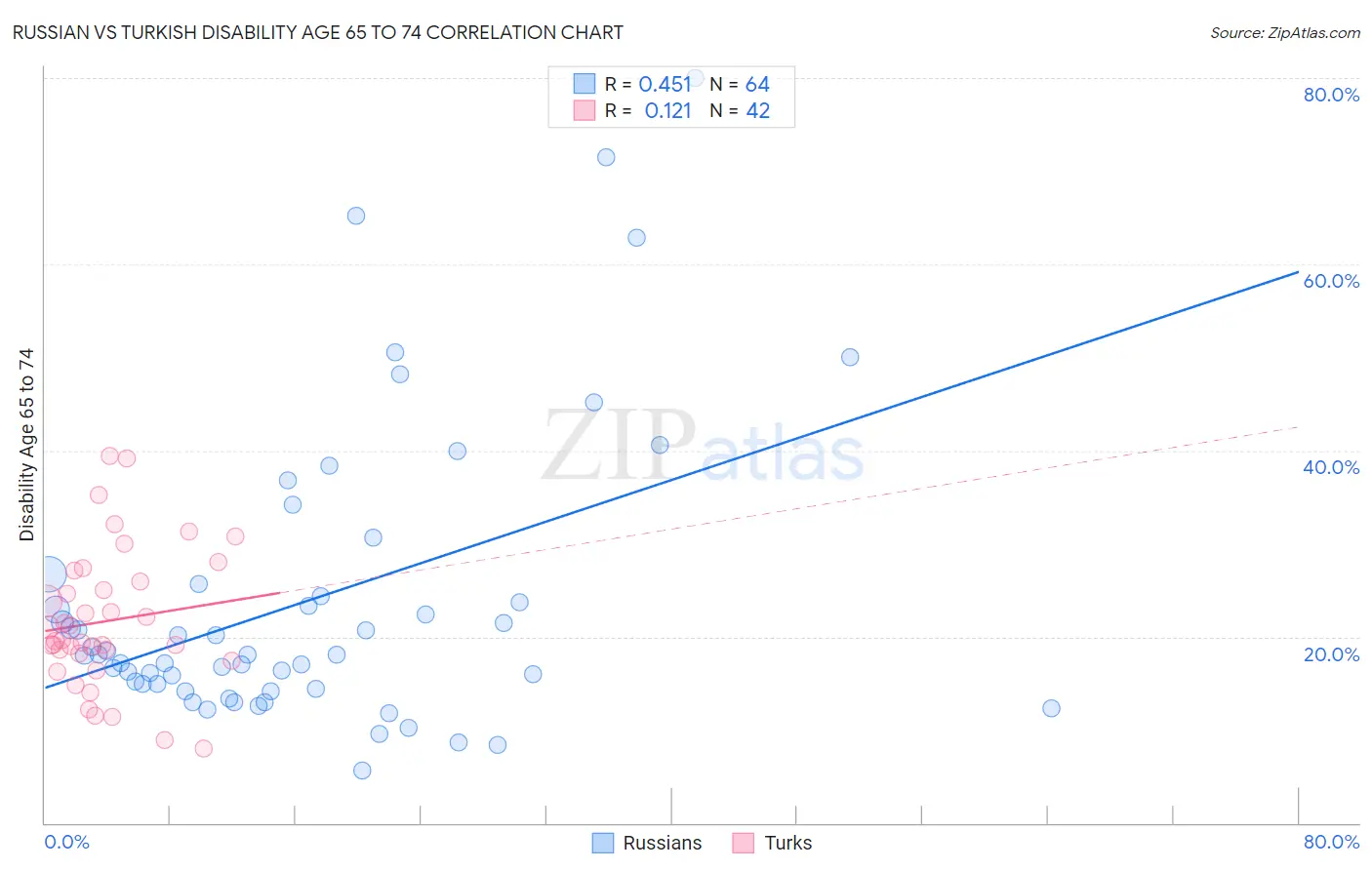Russian vs Turkish Disability Age 65 to 74
COMPARE
Russian
Turkish
Disability Age 65 to 74
Disability Age 65 to 74 Comparison
Russians
Turks
21.2%
DISABILITY AGE 65 TO 74
99.8/ 100
METRIC RATING
38th/ 347
METRIC RANK
21.0%
DISABILITY AGE 65 TO 74
99.9/ 100
METRIC RATING
32nd/ 347
METRIC RANK
Russian vs Turkish Disability Age 65 to 74 Correlation Chart
The statistical analysis conducted on geographies consisting of 510,598,178 people shows a moderate positive correlation between the proportion of Russians and percentage of population with a disability between the ages 65 and 75 in the United States with a correlation coefficient (R) of 0.451 and weighted average of 21.2%. Similarly, the statistical analysis conducted on geographies consisting of 271,478,779 people shows a poor positive correlation between the proportion of Turks and percentage of population with a disability between the ages 65 and 75 in the United States with a correlation coefficient (R) of 0.121 and weighted average of 21.0%, a difference of 0.59%.

Disability Age 65 to 74 Correlation Summary
| Measurement | Russian | Turkish |
| Minimum | 5.7% | 7.9% |
| Maximum | 80.0% | 39.4% |
| Range | 74.3% | 31.5% |
| Mean | 23.9% | 21.7% |
| Median | 18.1% | 19.6% |
| Interquartile 25% (IQ1) | 14.7% | 18.2% |
| Interquartile 75% (IQ3) | 25.0% | 26.0% |
| Interquartile Range (IQR) | 10.4% | 7.8% |
| Standard Deviation (Sample) | 15.8% | 7.4% |
| Standard Deviation (Population) | 15.7% | 7.3% |
Demographics Similar to Russians and Turks by Disability Age 65 to 74
In terms of disability age 65 to 74, the demographic groups most similar to Russians are Israeli (21.2%, a difference of 0.0%), Immigrants from Switzerland (21.1%, a difference of 0.11%), Argentinean (21.2%, a difference of 0.18%), Bulgarian (21.1%, a difference of 0.30%), and Latvian (21.2%, a difference of 0.35%). Similarly, the demographic groups most similar to Turks are Immigrants from Northern Europe (21.0%, a difference of 0.030%), Immigrants from Greece (21.0%, a difference of 0.070%), Immigrants from Japan (21.0%, a difference of 0.11%), Immigrants from Czechoslovakia (21.0%, a difference of 0.15%), and Immigrants from Argentina (21.1%, a difference of 0.20%).
| Demographics | Rating | Rank | Disability Age 65 to 74 |
| Bolivians | 99.9 /100 | #25 | Exceptional 21.0% |
| Immigrants | Australia | 99.9 /100 | #26 | Exceptional 21.0% |
| Immigrants | Sweden | 99.9 /100 | #27 | Exceptional 21.0% |
| Immigrants | Czechoslovakia | 99.9 /100 | #28 | Exceptional 21.0% |
| Immigrants | Japan | 99.9 /100 | #29 | Exceptional 21.0% |
| Immigrants | Greece | 99.9 /100 | #30 | Exceptional 21.0% |
| Immigrants | Northern Europe | 99.9 /100 | #31 | Exceptional 21.0% |
| Turks | 99.9 /100 | #32 | Exceptional 21.0% |
| Immigrants | Argentina | 99.9 /100 | #33 | Exceptional 21.1% |
| Immigrants | Sri Lanka | 99.9 /100 | #34 | Exceptional 21.1% |
| Bulgarians | 99.9 /100 | #35 | Exceptional 21.1% |
| Immigrants | Switzerland | 99.8 /100 | #36 | Exceptional 21.1% |
| Israelis | 99.8 /100 | #37 | Exceptional 21.2% |
| Russians | 99.8 /100 | #38 | Exceptional 21.2% |
| Argentineans | 99.8 /100 | #39 | Exceptional 21.2% |
| Latvians | 99.8 /100 | #40 | Exceptional 21.2% |
| Immigrants | Austria | 99.8 /100 | #41 | Exceptional 21.2% |
| Macedonians | 99.7 /100 | #42 | Exceptional 21.3% |
| Immigrants | Croatia | 99.7 /100 | #43 | Exceptional 21.3% |
| Estonians | 99.7 /100 | #44 | Exceptional 21.4% |
| Asians | 99.7 /100 | #45 | Exceptional 21.4% |